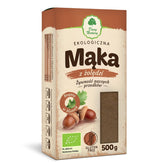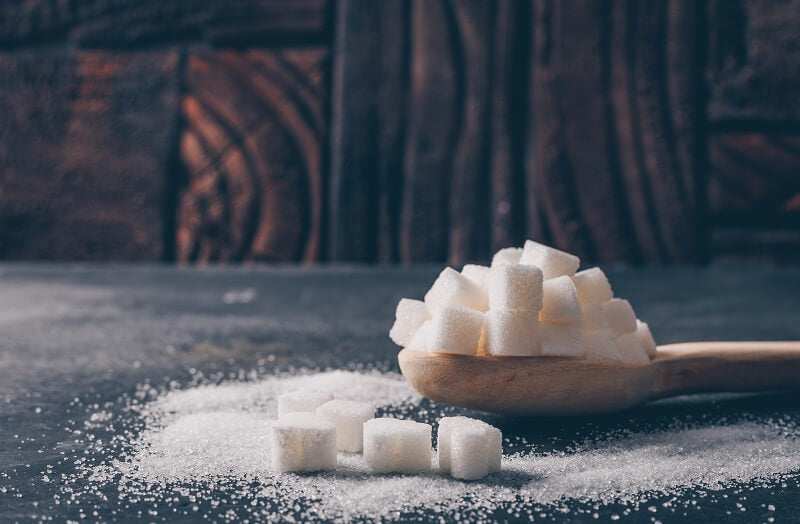Which sweetener should I choose? Xylitol or erythritol, or perhaps maltitol or stevia?
TABLE OF CONTENTS
- A few words about sweeteners
- Xylitol – birch sugar
- Erythritol – a popular erythritol
- Maltitol – what is it?
- Stevia – almost 300 times sweeter than sucrose
- Which sweetener should I choose? - Summary
Sweeteners have gained significant popularity in recent years. This trend is evident among both consumers and manufacturers, who regularly add new products containing these sweeteners to their ranges. The fundamental question, however, is which sweetener to choose from this wide range. It will come as no surprise that the selection is quite extensive. Therefore, it's worth delving into this topic and learning a little more about them. Each of them has slightly different properties and origins.
A few words about sweeteners
First of all, it should be noted that the sweet taste is not exclusive to sugar. Many substances can produce a sweetening effect on the tongue. These chemical compounds are called sweeteners. They can be divided into those of natural origin and those obtained synthetically. Natural sweeteners were discovered at the end of the 19th century, and the first synthetic sweetener was saccharin, synthesized in 1987. The actual mechanism of action of sweeteners on the sense of taste and on the entire body is quite similar to that of ordinary white sugar. An important difference, however, lies in their calorific value, as sweeteners naturally have an extremely low, even zero, energy value. We perceive the sweet taste when the receptors on the tongue and in the depths of the oral cavity react with the corresponding molecules. The information about the sweet taste then reaches our brain. The intensity of the sweet taste depends on the intensity of the effect of these molecules on our taste receptors. The stronger the effect, the sweeter the taste we perceive. Interestingly, no completely independent system for measuring the sweetness of individual chemicals has yet been discovered. Therefore, all measurements are based on sensory tests using sucrose, the white food sugar. The standard for such a measurement is a 10% aqueous solution of this sugar, whose sweetness is assumed to be 1. On this basis, one can assess how many times sweeter or less sweet a particular sweetener is than sucrose.
Xylitol – birch sugar
Xylitol is a naturally occurring sweetener that offers a healthy alternative to white sugar. It belongs to the group of polyols, or sugar alcohols. They are characterized by very low absorption by the body. However, its metabolism itself occurs without the involvement of insulin, so blood sugar levels are not elevated. Xylitol is extracted from the bark of the Finnish birch tree, but interestingly, the human body also produces it in very small amounts. Due to its very low glycemic index (GI=8), the use of this sweetener is especially recommended for diabetics. It is several times lower than sucrose. In addition, one gram of xylitol contains 2.4 kcal, compared to almost 4 kcal in regular white sugar. This is great news for people looking to lose weight. It is worth mentioning that the taste of this sweetener is very similar to that of sucrose. Interestingly, it can increase calcium absorption by the bones, which is why its use is recommended for children three years and older, as well as for adults struggling with bone demineralization. It's worth noting that white sugar has the opposite effect.
Erythritol – a popular erythritol
Erythrol is another member of the polyhydroxy alcohols (sugar alcohols). Like xylitol, it occurs naturally, but is commercially available as a synthetic sweetener. It is obtained from waste glycerol using a specific type of yeast that converts it into this sweetener. However, you shouldn't be afraid of it, as it is one of the safest synthetic sweeteners. Its zero glycemic index makes it an ideal choice for anyone trying to control their blood sugar levels. Furthermore, it may have a positive effect on reducing free oxygen radicals and preventing the development of cavities. Interestingly, it is less sweet than sucrose, with its sweetness being between 60 and 70% of that of white sugar. Furthermore, it is not metabolized by our bodies at all. As a result, it has virtually no energy value, and is excreted in the urine. One gram of erythritol is estimated to contain between 0.2 and 0.4 kcal. Also worth mentioning is erythritol . It's most often compared to the aforementioned xylitol. The debate over which is healthier and should be the preferred sweetener has been going on for a long time. However, both sweeteners are equally healthy and safe to use. There's really little difference between them, and very often the final selection criterion is simply taste.
Maltitol – what is it?
Compared to its two predecessors, maltitol is not as popular a sweetener as its predecessors. Like xylitol and erythritol, it belongs to the group of sugar alcohols and occurs naturally in plants. However, on an industrial scale, it is extracted from cereal grains. Corn is most commonly used for this purpose. Maltose is isolated using a suitable process and then subjected to reduction processes. Despite these treatments, this sweetener is still very safe due to the absence of additives. Due to the extraction process itself, its properties are very similar to those of ordinary white sugar. Interestingly, maltitol does not change its physicochemical properties even under the influence of very high temperatures. This makes it ideal for all types of baking. Like sucrose, it only caramelizes. In terms of energy value, it is twice as calorie-free as sugar. One gram of this sweetener contains approximately 2 kcal. Maltitol as a sugar substitute is recommended for people on a gluten-free diet, as well as for those suffering from lactose intolerance and wanting to lose weight. Like its predecessors, it does not cause cavities and can be used successfully by diabetics. Maltitol's absorption process is much slower than that of sucrose and, in addition, does not cause such large insulin surges. It also has a low glycemic index, although blood sugar levels should be monitored after consumption. Interestingly, its use should also be considered by patients with glucose intolerance.
Stevia – almost 300 times sweeter than sucrose
Stevia belongs to the daisy family (Asteraceae) and has been used as a sugar substitute for centuries. These plants occur naturally in the Americas. Also called malt herb, it is a completely natural sweetener. Stevia's leaves and stems contain steviol glycosides, which are responsible for its sweet taste. These chemicals are up to 300 times sweeter than sugar, and one teaspoon of stevia is equivalent to the sweetness of an entire glass of white sugar. Stevia is practically the sweetest sweetener of purely natural origin. And all this with virtually no calories. Sounds pretty utopian, and until 2010, steviol glycosides were suspected of having many potentially negative health effects. The most common claims were that they caused the development of cancer and were dangerous to fetuses and pregnant women. However, in 2011, all these suspicions were refuted, and stevia was officially recognized as a completely safe food additive, better known as E960. However, it should be noted that the safe daily dose of stevia is 4 mg per kilogram of body weight. In addition to its very sweet taste, it can be helpful in fighting the bacteria that cause Lyme disease, but it is also completely safe for people with phenylketonuria and diabetics. Equally interesting is the fact that recent research suggests it could potentially support pharmacotherapy for hypertension and other cardiovascular diseases.
Which sweetener should I choose? - Summary
It probably won't come as a big surprise to say that there is no clear answer to this question. All the sweeteners presented in this article are very healthy and equally safe. It all depends on what we expect from a particular sweetener. The first criterion, of course, is taste. If we're looking for something that tastes similar to white sugar, xylitol or maltitol are the best choices. However, if we want the lowest possible energy value, it's worth considering stevia and erythritol. In addition, the sweeter the sweetener, the less we need it to achieve the right sweetness level, which is why a much smaller amount of stevia will certainly keep longer than, for example, the same amount of erythritol. It will certainly be more beneficial for our wallet. We can base our decision on the criterion of the sweetener's complete naturalness or the lowest degree of its processing. In this case, the obvious choice will certainly be xylitol or stevia. The most important thing is that the sweetener simply tastes good and meets our expectations.
THE PUBLISHER'S CHOICE
Dried plums 1 kg BIOGO
- €7,01
- €7,01
- Unit price
- / per
Dried White Mulberries 500 g ORGANIC
- €5,84
- €5,84
- Unit price
- / per
Almonds 1 kg BIOGO
- €11,69
- €11,69
- Unit price
- / per
Cranberries sweetened with apple juice organic 1 kg BIOGO
- €16,37
- €16,37
- Unit price
- / per
Dried dates 1 kg BIOGO
- €4,21
- €4,21
- Unit price
- / per
Unpeeled buckwheat groats 1 kg BIOGO
- €2,81
- €2,81
- Unit price
- / per
Walnuts 800 g BIOGO
- €8,65
- €8,65
- Unit price
- / per
Peeled sunflower seeds 1 kg BIOGO
- €3,04
- €3,04
- Unit price
- / per
PULLED ORGANIC SUNFLOWER SEEDS 1 KG BIOGO
- €4,44
- €4,44
- Unit price
- / per












































































































































